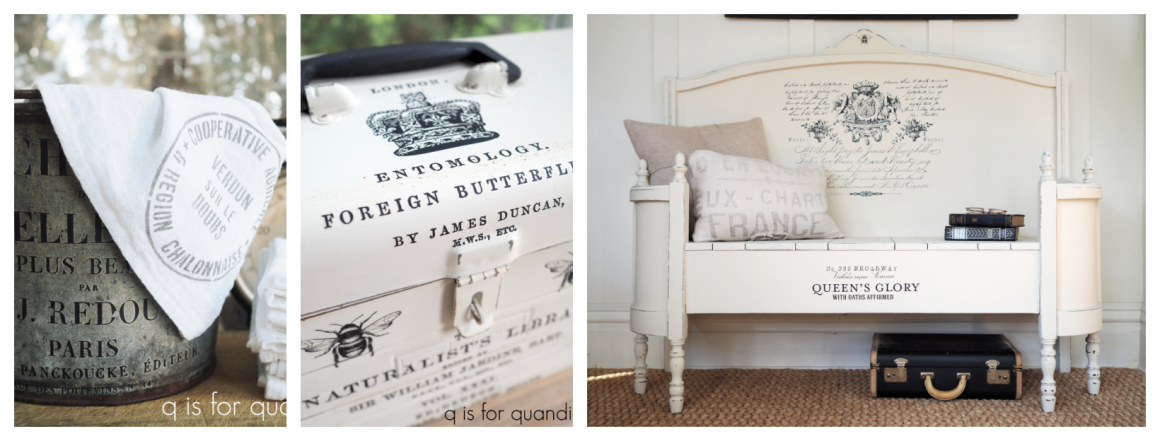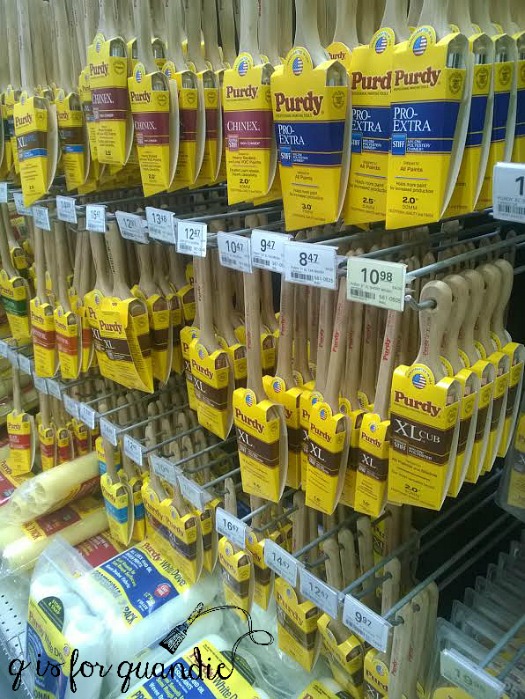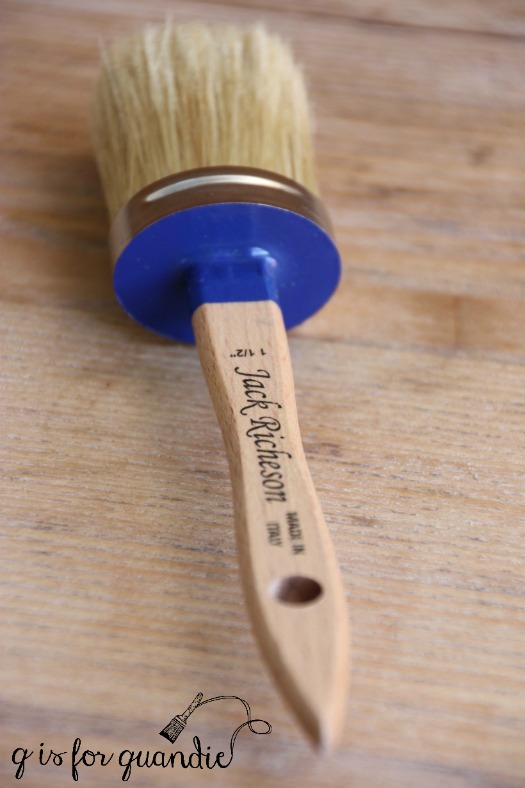Recently I’ve had several requests for a post about brushes and what kinds work best for which tasks or products. At first I demurred because I don’t consider myself an expert on brushes, and in fact don’t really have any technical knowledge about them. But then I realized that I could certainly do some research, much like I did with my post about waxes. Plus, I really have to give myself credit for the fact that I have painted well over 200 pieces of furniture … all with a brush! Surely that experience counts for something.
As I started to think about it, I realized in fact that I had way more info to share than I could include in just one post so welcome to brush week! Yeah, that’s a terribly lame name, but I really couldn’t come up with anything more clever. Maybe you guys have some suggestions? Anyway, today we’ll be talking about paint brushes. Wednesday I’ll dive into brushes for other tasks such as stenciling and waxing. And finally on Friday, the best ways to clean your brushes.
My goal is to keep this information completely unbiased so I’m not including any links for purchasing products, etc. I’m sure that if you want to try something I’m writing about you’ll be clever enough to figure out where to buy it, right?
OK, so let’s get started.
I don’t know about you, but when I walk into my local hardware store to buy a new paint brush I am quickly overwhelmed by my options.
For goodness sake, look at them all! And that’s just the Purdy’s. There are so many options, so let’s talk about a few of them.
Natural v. synthetic bristles.
Somehow it seems like natural should always be better than synthetic, right? That’s not necessarily so with paint brushes. When using water based products like Fusion paint, chalk paint, milk paint or even just latex paint, you need to go with synthetic bristles. Natural bristles will absorb the water in these products causing the bristles to swell and lose their shape. Natural bristles are best reserved for use with oil based products.
Phew, that one was easy. Just choose synthetic.
Nylon v. polyester.
Now that the synthetic decision is made, of course there is more than one type of synthetic bristle. Nylon or polyester. Both will work fine with water based products. Nylon bristles will be softer than polyester. When working with heavier paints, like a chalk paint, I like to use a stiffer bristle (ie. polyester). I also prefer it with milk paint because I feel like it gives me more control over the paint. In fact I really prefer a good stiff brush overall (wink, wink). Except when using Fusion paint, then I reach for the softer Purdy Nylox brushes. They give a smoother finish and are less likely to leave brush strokes.
Another choice you’ll have to make with a traditional paint brush (we’ll talk about those round brushes in a bit) is whether you want an angled brush or a flat brush. I use an angled brush about 99% of the time. It’s easier to get into those corners on the paneled side of a dresser like this one with an angled brush.
I do own one flat brush, but the only time I use it is when I’m painting something with lots of big flat expanses, like maybe a table top or a large chalkboard.
Does size matter?
Of course it does! If your brush is too small it will take forever to get your piece painted, and if it’s too big you’ll have trouble with those little detail-y bits. Plus the larger your brush, the more paint it holds and the heavier it gets. In the end, my hand just gets too tired wielding a larger brush. So I mainly use just two sizes of paint brushes. I’ll use a smaller 1.5″ brush for painting narrow things like a mirror frame for example. For most pieces of furniture I use a 2″ brush. I almost never use anything larger than a 2″ brush for furniture. I do have a couple of bigger brushes, but I use them for painting the house.
And what about those fancy round or oval brushes that are all the rage?
Yep, that brings me to the big round or oval brushes that you see so many furniture painters using. They look so appealing in those youtube videos or in those really pretty pictures on blogs, don’t they? I’ve tried to find some definitive data on whether or not they are preferable to a traditional paint brush for applying paint to furniture but the only reason I have found for using them is that they hold more paint and thus reduce the numbers of times you have to dip your brush to reload. Theoretically they shorten the time needed to paint your piece, and perhaps that is true. But as I mentioned above, the added weight of that paint on the brush is a problem for me.
I’ve never painted with these brushes, but I have used them for wax (more on that Wednesday). However, I have this smaller 1.5″ version that Fusion sent to me quite some time ago that I’d never used (mainly because the 1.5″ size seems a bit small for painting furniture).
So I opened it up, got out some Fusion paint and painted this small clay pot just to try it out.
This is a mix of Fusion’s Algonquin and Casement that I happen to have stored in a Talenti sorbetto container. The brush does live up to my expectations regarding the quantity of paint that it holds. I was able to paint the entire outside of the pot with one dip of paint. However, as soon as I started using this brush I felt like it was too stiff for Fusion paint. It gave me a lot more brush strokes than I’m used to. It was also tough to get into the interior bottom corners of the pot with that big round blunt end, an angled brush would have worked better for that. Bottom line, I think these round brushes are best reserved for use on projects where you want to see some texture (ie. brush strokes) and/or are using a heavy bodied paint such as chalk paint. If you want a smoother look, stick with a traditional synthetic brush.
One last note. You might be wondering why I use Purdy brushes and not some other brand. The honest answer is that the first brush I bought was a Purdy and I loved it. So now I just keep going back to them without really trying any other brand. They aren’t overly expensive and they are a nice quality brush. I have lots and lots of brushes. In the summer I’ve been known to have half a dozen projects going at once, which means I need 6 brushes unless I want to wash a brush between each coat. And on the other side of the coin, I am also not very good at caring for my brushes properly so I don’t want to spend a lot of money on a brush and then have to toss it because I forgot to clean it (more on that Friday).
I hope you found some of this information helpful. I can sum everything up by saying that if I had to pick one brush that I use the most it would be a 2″ angled polyester brush for chalk and milk paint, or the nylon version for Fusion paint. You can get a good quality brush for $12 to $15.
Be sure to check back on Wednesday for a post about brushes used for other tasks.









Thank you so much for doing this. It is so informative!
LikeLike
You’re welcome Janie, and thanks for taking the time to leave comment!
LikeLike
Love this information. One of the best things in the post was your use of the word demurred. Excellent choice.
LikeLike
It definitely fit 😉
LikeLike
Such good information. I’ve used Purdy brushes for years. I love them too. Looking forward to Friday’s post. If you have any advice for salvaging paint brushes that didn’t get cleaned and the paint dried I’m all ears. We recently helped my son and daughter in law paint their newly renovated home and two of my brushes were accidentally left to dry without being cleaned.
LikeLike
Well, I am going to talk about that on Friday so be sure to check back!
LikeLike
There’s a Brush Cleaner on the market from Fusion, and it’s made of pure linseed oil. I’ve read that you an slather it on dried paint on brushes, leave it for a few days, and it will loosen the paint so you can wash it 🙂
LikeLike
Shhhh, you’re giving away my Friday post Melanie 😉
LikeLike
Thank you! I’m so excited about Brush Week! Good info, as always.
LikeLike
You’re welcome grasshopper!
LikeLike
I love Purdy brushes too!!!!
LikeLike
They hold up well and are reasonably priced, what’s not to love, right?
LikeLike
Thank you! Terrific information! I am looking forward to the rest of Brush week. I too have forgotten brushes and had to toss out a few that were beyond hope of rescuing. I also love the Purdy line and almost always use the 2″ angled brush. Years ago I use to paint landscapes, seascapes etc in oils and almost all of my brushes were natural boar hair bristles which were very expensive and cleaned using solvents. I only had to toss a few from forgetting to clean them properly. In the past, I have used fabric softener to clean/rinse rollers used for Latex paint but have never used it with my Purdy brushes. Thanks again!
LikeLike
I have heard of using fabric softener too, but have never tried it.
LikeLike
Thanks so much for a very helpful post!
LikeLike
You’re welcome Laura!
LikeLike
Thanks for the great info!
LikeLike
You’re welcome!
LikeLike
Thank you for the info and the summary in your last paragraph.
LikeLike
You bet Deb!
LikeLike
Love me some Purdy! I appreciate your in-depth study on style, function and type of brushes per project. You must be a researcher in your other life. I do have a stash of chip brushes when I have to slap-dash layer on paint and lack time. As for cleaning and loosening dried on paints-vinegar works pretty well or my go-to Brush Cleaner by Klean Strip (Barr). Drop in guests will think they wandered into a mortuary so use it judiciously. Thanks as always for premier information.
LikeLike
I’ll have to try vinegar for sure. I love any product that can double as a food item. That being said, I’m guessing that the Brush Cleaner by Klean Strip might be a little too toxic for me. Anything that requires chemical-resistant gloves and chemical splash goggles for use sounds a tad scary. I think I’d rather toss those brushes and start over 😉
LikeLike
Very interesting info Sis.
LikeLike
Thanks sis.
LikeLike
I think you are a pro for sure Linda 🙂 I love all your info. I do have to say though that I was converted last year to the natural round bristle brushes. I was a skeptic and loved my synthetic angled, but I found they actually did a better job of providing a smooth, minimal stroke finish. So maybe it’s a preference thing? I haven’t tried them with milk paint though, I imagine they would hold too much.
LikeLike
I was fully expecting to love that round brush, I really was. But the reality is that I didn’t. I really do feel like I get less brush strokes with Fusion paint in particular using a Nylon bristle. But thanks for sharing your preference. And if any other readers out there prefer the round brush, I hope that they will weigh in as well!
LikeLike
Great info here, looking forward to the rest of your brush posts. My grandfather, a general contractor taught me how to paint walls, wood work, etc, many years ago! Purdy was the only brushes he used, and I have kept that tradition going. And you under estimate your expert knowledge, your work always looks fantastic!
LikeLike
Thank you Paula! I figure I’ve gotten this far with my Purdy brushes, so they must be doing the trick!
LikeLike
I don’t have any idea how many projects I have paint, but I am a Purdy girl: All the Way. Tried others (cheaper and more expensive) but always go back to my Purdy’s! Curious how you “preserve” between coats, overnight or when you are able to get back at it. I use aluminum foil wrapped around my brush bristles….seems to work well.
LikeLike
I am going to address that in my post on Friday, so be sure to check back 😉
LikeLike
Great post, Linda! My brush of choice is a 1-1/2 to 2″ Purdy angled brush, too. Anything bigger and my hand cramps up. I have round wax brushes but find them unwieldy to use…and you’re right…they do leave a lot of brush strokes. For very small projects, I often just grab a foam brush…
Looking forward to more!
LikeLike